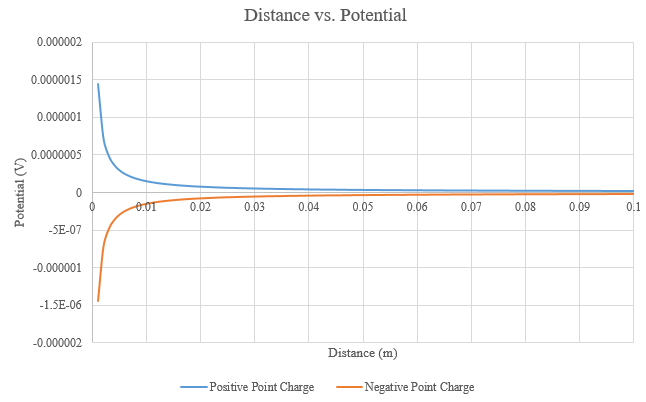Potential Difference at One Location
Written by Alex George
The Main Idea
Usually, we are interested in the potential difference between two different points. However, it is also useful to determine potential at a single location.
In this case, we must define the potential at a location (ex. Location A) as the potential difference between a point infinitely far from all other charged particles and the location we defined.
As potential has a value at all locations at space, it is a scalar field in it of itself.
A Mathematical Model
Potential at One Location
[math]\displaystyle{ V_{a} = V_{a} - V_{\infty } }[/math] where [math]\displaystyle{ V_{a} }[/math] is the potential location of interest and [math]\displaystyle{ V_{\infty } }[/math] is the potential at a location infinitely far away.
This equation is only valid when [math]\displaystyle{ V_{\infty } }[/math] is equal to zero.
Potential near a Point Charge
Parameters: A point charge with charge [math]\displaystyle{ q }[/math]. We are a distance [math]\displaystyle{ x }[/math] from this point charge and we want to find the potential difference between our point charge and the potential at infinity.
[math]\displaystyle{ V_{x} = V_{x} - V_{\infty } = -\int_{\infty }^{x} \frac{1}{4\pi\varepsilon _{0} } \frac{q}{x^2} dx = \frac{1}{4\pi\varepsilon _{0} } (\frac{q}{x}-\frac{q}{\infty}) = \frac{1}{4\pi\varepsilon _{0}} \frac{q}{x} }[/math]
The sign of the potential depends on the sign of the charge on the particle:
if [math]\displaystyle{ q \lt 0, V_{x} \lt 0 }[/math]
if [math]\displaystyle{ q \gt 0, V_{x} \gt 0 }[/math]
Potential Energy at a Single Location
Once the value of the potential at one location is known, the potential energy of a system can be calculated.
If a charged object was placed at the location where the potential is known, then the potential energy of the system would be given the the equation:
[math]\displaystyle{ U_{A} = qV_{A} }[/math]
Substituting in the derived equation from the previous section for [math]\displaystyle{ V_{A} }[/math], we obtain the following:
[math]\displaystyle{ U_{A} = q_{1} (\frac{1}{4\pi\varepsilon _{0}} \frac{q_{2}}{x}) = (\frac{1}{4\pi\varepsilon _{0}} \frac{q_{1}q_{2}}{x}) }[/math] where [math]\displaystyle{ x }[/math] is the separation between the two particles, and [math]\displaystyle{ q_{1} }[/math] and [math]\displaystyle{ q_{2} }[/math] are the respective charges of the particles.
A Visual Model
A visualization of Distance vs. Potential from a point charge is given by Figure 1:
Figure 1. Potential vs. Distance for a Point charge with Charge [math]\displaystyle{ e }[/math]
The electric field of the point charge can bet obtained by differentiation. The negative gradient of the potential with respect to distance would yield the electric field:
[math]\displaystyle{ E_{x} = -\frac{\partial V}{\partial x} }[/math]
Examples
Here are a couple of problems that illustrate the concepts presented above.
Simple
Example 1
1) What is the electric potential 5 cm away from a 1 cm diameter metal sphere that has a -3.00 nC static charge?
Solution:
As the distance from the center of the sphere is greater than the radius, we can treat the metal sphere as a point charge.
From the above derivation of the potential for a single point charge, we have:
[math]\displaystyle{ V_{x} = V_{x} - V_{\infty } = -\int_{\infty }^{x} \frac{1}{4\pi\varepsilon _{0} } \frac{q}{x^2} dx = \frac{1}{4\pi\varepsilon _{0} } \bigg(\frac{q}{x}-\frac{q}{\infty} \bigg) }[/math]
[math]\displaystyle{ V_{x} = 9\times 10^{9} \frac{N\cdot m^{2}}{C^{2} } \bigg(\frac{-3.00\times 10^{-9}\ C}{5.00\times 10^{-2}\ m}-\frac{q}{\infty}\bigg) = 9\times 10^{9} \frac{N\cdot m^{2}}{C^{2} } \frac{-3.00\times 10^{-9}\ C}{5.00\times 10^{-2}\ m} = -539 V }[/math]
Example 2
2) What is the excess charge on a Van de Graff generator that has a 25.0 cm diameter metal sphere that produces a voltage of 50 kV near the surface?
Solution
The potential of the surface will be the same as that of a point charge from the center of the sphere, 12.5 cm away. The excess charge can be derived from the equation for potential a distance away from a point charge:
[math]\displaystyle{ V_{x} = \frac{1}{4\pi\varepsilon _{0} } \bigg(\frac{q}{x}\bigg) }[/math]
[math]\displaystyle{ q = {4\pi\varepsilon _{0}} x V_{x} }[/math]
[math]\displaystyle{ q = \frac{1}{9\times 10^{9}} \frac {N\cdot m^{2}}{C^{2}} (12.5 \times 10^{-2} \ m) (50 \times 10^{3} \ V) = 6.94 \time 10^{-7} \ C }[/math]
Difficult
Connectedness
- How is this topic connected to something that you are interested in?
- How is it connected to your major?
- Is there an interesting industrial application?
History
Put this idea in historical context. Give the reader the Who, What, When, Where, and Why.
See also
Are there related topics or categories in this wiki resource for the curious reader to explore? How does this topic fit into that context?
Further reading
Books, Articles or other print media on this topic
External links
References
This section contains the the references you used while writing this page
